Next to the Julian date, there might be a code starting with the letter ‘P’ – this is the plant code showing where the eggs were processed. This information is very helpful in case eggs need to be recalled. Knowing the plant code can help you determine if your particular box is part of the recall. It may seem small, but it is very important to make sure that the eggs you eat are safe.
The Importance of This
You might be wondering why all of this matters. Why is it important to know the Julian date and the plant code? Sure, let me clarify this for you.
Some years back, many eggs had to be taken off the market due to salmonella contamination. I remember it like it was yesterday because I bought a few boxes from the store. I started to worry when I thought about whether the eggs in my fridge were part of the ones being taken off the market. But then, I recalled the code for the plant and the specific date. I looked around and felt relieved because they were not in danger.
Eggs don't last forever.
Another important aspect related to these codes is how to manage the eggs to keep them fresh. Eggs can be eaten up to 30 days after they were packed as long as they are stored properly. The Julian date can help you with that.
I have made it a habit to check the Julian date as soon as I arrive home from the store. It's similar to a little ceremony. I write the date, do a quick math calculation, and remember when to use them. It's an easy trick that ensures I always use fresh eggs, making a big difference in the flavor of the food.
Quality and safety are important, not just expiration dates.
Even though knowing the date and where the eggs come from is important, there are other factors to consider to make sure you are getting the highest quality eggs. You can also check for other signs on the box, like the USDA grade symbol and the words "pastured" or "organic" if that's what you want.
Another benefit of eggs with the USDA grade shield is that they have been checked for quality and meet specific standards. Grade AA eggs are the highest quality eggs. They have thick egg whites and a firm yolk, making them perfect for frying or poaching. Grade A eggs are a little less firm than Grade AA eggs, but they are still excellent for cooking and baking.
Eggs from free-range chickens.
If you prefer eggs from chickens that roam freely, you should search for labels like 'organic' or 'pastured.' Organic eggs are produced by chickens that eat organic food and do not receive antibiotics. Cage-free eggs come from chickens that can roam freely and eat natural food, resulting in tastier eggs.
Let me explain how I connected all this information. One Saturday morning, I chose to cook an omelet. I reached for the carton of eggs, checked the date on it, and felt relieved - these eggs were packed only a week ago. They were new and flawless. I broke a few eggs into a bowl; their yolks were orange and thick, showing they were fresh.
Next, I added milk, salt, and freshly ground pepper to the mixture while stirring. I put a bit of butter in the pan and let it sizzle, then I broke the eggs into it. The omelet puffed up nicely. I put sautéed mushrooms and cheese on top and then folded it. It was the best omelet I had made in a long time, and I think it was because the eggs were very fresh.
Next time you have a carton of eggs in your hands, try to figure out the codes. Knowing the Julian date and the plant code when buying eggs is not just about gaining information, it's about making sure the eggs you eat are high quality and safe. From making scrambled eggs in the morning to baking a cake in the evening, knowing what those numbers represent can help you improve your cooking skills with eggs.
In the end, it is a small but pleasant part of the cooking experience. Who wouldn't want to learn something new while eating breakfast?
Understanding the Numbers on Your Egg Carton Have you ever wondered what the numbers on your egg carton mean?

Dessert is a guaranteed hit for the weekend
November 11, 2025

Creamy Seafood Salad with Imitation Crab
November 10, 2025

Chicken Spinach and Mushroom Low Carb Oven Dish
November 05, 2025




